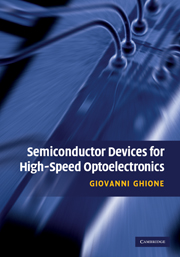6 - Modulators
Published online by Cambridge University Press: 03 February 2010
Summary
Light modulation and modulator choices
LEDs and lasers biased at a constant current emit CW (continuous wave) light with constant average optical power. To transmit information we need to modulate the light source by changing its amplitude and/or phase. For simplicity, we will consider only intensity modulation (IM), where digital or analog information is associated with the light's instantaneous power. In digital IM, binary symbols are associated with intervals of high (ON state) or low (OFF state) optical power; the power ratio between the ON and OFF states is the extinction or contrast ratio (ER or CR), while the maximum bit rate (maximum bandwidth) of the modulation process is the modulation speed (or modulation bandwidth).
Light modulation can be internal (direct) or external (indirect). Direct modulation is based on the modulation of the instantaneous bias point of the light source (LED or laser); the solution is compact, since no additional external device is required, but has worse extinction ratio and a higher chirp (i.e., spurious frequency modulation associated with the intensity modulation) than indirect modulation schemes. The modulation bandwidth is very limited (below 1 Gbps) in LEDs, much wider (up to 10 Gbps in the field) for lasers.
External (indirect) modulation requires an additional (sometimes large and separately packaged) voltage-driven device, the light modulator, acting as a light switch; see Fig. 6.1. The advantages are a higher extinction ratio, lower chirp (ideally zero in some devices), and higher bit rate (above 40 Gbps).
- Type
- Chapter
- Information
- Semiconductor Devices for High-Speed Optoelectronics , pp. 356 - 439Publisher: Cambridge University PressPrint publication year: 2009
- 3
- Cited by

